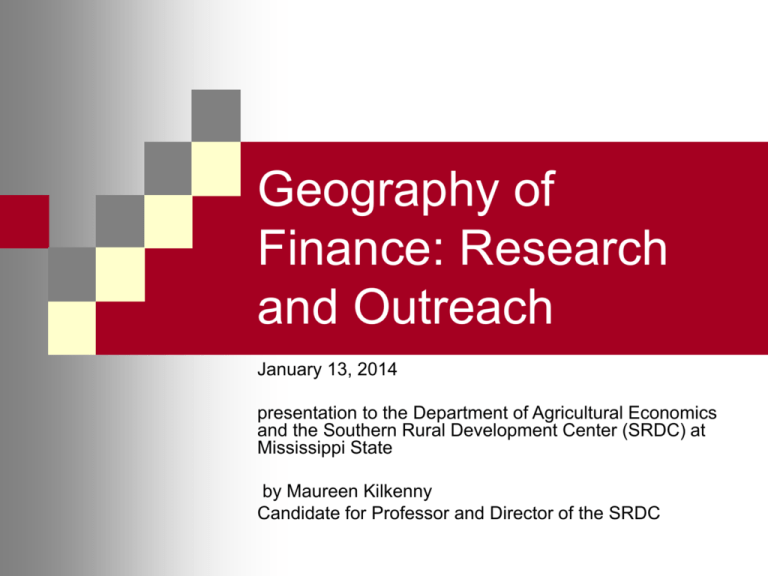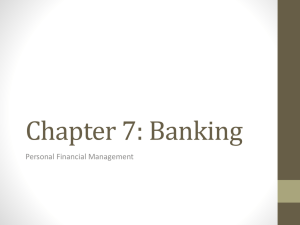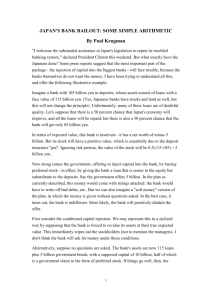PowerPoint
advertisement

Geography of Finance: Research and Outreach January 13, 2014 presentation to the Department of Agricultural Economics and the Southern Rural Development Center (SRDC) at Mississippi State by Maureen Kilkenny Candidate for Professor and Director of the SRDC Outline Bio & Experience Geography of Finance In-reach Research Outreach Extension & Research Synergies Discussion 23 total slides 2 Bio sketch Produce buyer & founding member, Davis Food Co-op, 1972-76 Chair, North Oakland Center Council, Berkeley Co-op, 1977-79 MS & PhD, U. Minnesota, Ag. and Applied Economics, 1981-87 Economist, Economic Research Service, USDA, 1987-88 Asst. Prof., Dept. of Economics, Penn State, 1989-91 Asst. Prof., Economics Institute, CU Boulder, 1991-93 Asst->Assoc. Prof., Dept. of Economics, Iowa State, 1994-2005 Prof., Dept. of Resource Economics, UNR, 2005-11 Distinguished Visiting Professor, Business School, U. Wales, 2010Senior Fellow, NCFAP, 2010Science Officer, AgConversions, 2012- 23 total slides 3 Experience Tenured full professor with 22 years experience in four types of departments Domestic and internationally known researcher and scholar Award-winning teacher, advisor, mentor Director of undergraduate and graduate programs, advising, curriculum, assessment, recruitment, internships, awards, placement Founder of two national endowed graduate fellowship programs Founding director of three university-wide international academic exchanges Elected chairman of a wide variety of professional associations Dept, college P&T committee, chair; university panelist: Research; IRB; Sponsored Programs; Curriculum; member of Faculty Senate Longstanding partnerships with federal agencies (USDA, Fed, NSF,…) PD on millions $ multi-state, interdisciplinary, competitively-funded research Decades of voluntary service on local and state panels and committees 23 total slides 4 The In-reach ^^ 23 total slides 5 The Questions Wallace Foundation for Rural Research & Development 30 counties of SW Iowa Farmers, bankers, business people, housekeepers 1) “How can we tell if our economic development projects are working?” 2) “Why can’t our kids get loans so they can start a business and stay in our small towns?” “The banks just take our deposits and loan them to city borrowers to get a higher rate of return.” 23 total slides 6 Initial answers Network Analysis Prairie Dog Theory of Rural Development 1 micropolitan town 67 entities money, information, support Graph theory Keystone? banks businesses voluntary Gov’t 23 total slides 7 23 total slides 8 More initial answers Community Reinvestment Act National Survey of Small Business Finance 0% Microfinance 5% 10% 20% 25% 20% cash flow problems 15% insufficient collateral 8% business credit history 6% 5% too little equity Reasons for loan denial: 15% firm too young repayment doubtfull firm or loan too small 4% firm failed criteria large exisiting debt regulations loan too large for this bank personal credit history too far aw ay 23 total slides 3% 9 Distance from Primary Creditor 1993 NSSBF Kilkenny & Kim (2000) FREQUENCY(%) 35.0 30.0 MSA 25.0 NONMSA 20.0 15.0 10.0 5.0 0.0 0 2 4 6 8 10 20 More than 40 MILES About 85% of small businesses use a bank within 10 miles 23 total slides 10 The theory of credit rationing (Stiglitz & Weiss) Credit supply 23 total slides 11 Kilkenny’s hypothesis about effects of distance: There’s a distance after which no loans Credit supply are made no matter how high the i rate 23 total slides 12 Deposits v(B↑,Q,d) vA(A)↑ vA distance M’M 0 Assumption: savers are the decisive agents deposit at this bank if value, net of costs, exceeds the alternative: i(B) – c(F(d)/Q) ≥ vA(A) Implications: Deposits are increasing in population and bank size, And if costs c(F(d)/Q) are increasing and concave in distance, deposits convex in distance Also, market area “M” negatively related to competition if it is localized. 23 total slides 13 Loans Assumptions: information is asymmetric, distance is costly, and bankers lend to maximize their expected rate of return. 1 Q* b1 i * td b 1 1 Q * 1 t b 1 (i * td ) 0 d b 1 b 2 2Q * ?0 2 d decline convex or concave in distance Implications: loans decline with distance from lender, and after some distance, are no longer made 23 total slides 14 Empirically testable hypotheses: Common assumptions: Savers deposit in banks that offer the best interest rates. Bankers lend to maximize their rate of return. Deposit and loan markets are nationally competitive. Ho: No effect of distance on D or L Ho: No effect of local competitors on market area D(d) and L(d) are flat GRFI research assumptions: Savers deposit in banks that offer the best interest rates. Bankers lend to maximize their expected rate of return. Not all deposit and loan markets are competitive, nonmetro areas are often monopolized. Distance imposes costs D(d) strictly convex in distance L(d) concave & limited No one had ever documented D(d) or L(d) of community banks, which were 97% (3,891 of 4003) banks operating branches in the Midwest. 23 total slides 15 Data primary data: secondary data: FDIC Institution Directory postmarked invitation to each location executive Census population in zip Use your bank software to code areas generate: proportional sample of sum of deposits from each zip active commercial bank sum of loans to each zip area offices (size x pop) Return the file by email six Midwestern states We generate and send you GIS choropleth maps of your own deposit and loan market areas 23 total slides 16 23 total slides 17 23 total slides 18 1.00 Statistically significant evidence against the nulls ln(share of total) 0.10 D(d) strictly convex in distance, and L(d) concave & limited … as hypothesized 0.01 Deposits Loans 0.00 0.00 0.00 0 20 40 60 80 100 120 miles from branch office to transactor 23 total slides 19 Practical implications: Science-based answers to the WFRR&D questions, and more: 1. Banks funnel loans INTO rural towns. Bank lending is almost wholly contained within an hour’s drive from the branch office. In contrast, deposits (CDs) are acquired from coast-to-coast. 2. No-one without experience, collateral, cash flow history… gets a bank loan to start a business anywhere. 3. Local bankers are essential in community networks for sustainability. 4. Local bankers who do these things run more profitable bank branches. 5. It doesn’t matter where the bank HQ is located. 6. Because face-time matters, brick-and-mortar offices and community banks are likely to continue to be the main sources of external finance for established non-metro and small businesses, despite the existence of credit scoring and e-finance alternatives. 7. Explains why there are more bank offices than grocery stores today. 23 total slides 20 Preparing the FDIC data on 4,000 bank firms with 75,000 bank offices to measure ‘local competition” for the empirical tests (above) provided a nice piece of “market research” … showing counties where the firms are profitable and there are few offices. The red counties are where bank firms might consider opening a new branch. (2005 Outstanding Article Award Winner) 23 total slides 21 Extension & Research Synergies In-reachResearchExtension (1) satisfied clients and partners (2) learning opportunities for students (3) high-quality peer-reviewed research (4) new grant proposals (5) new Extension materials effective rural development? 23 total slides 22 Discussion Bio & Experience Geography of Finance In-reach Research Outreach Extension & Research Synergies 23 total slides 23 Thank you! Bank types with branches in the US Midwest, 2002 3,891 “community” banks 47% metro HQ & non-ag + 112 “large” banks 1,607 “Ag” banks 60% metro HQ 40% “rural” HQ 1,363 ”rural community” banks 70% “Ag” 30% non-ag 23 total slides 25







